Back
Pai Gow
(Chinese: "make nine") is perhaps the oldest casino gambling game,
originating in China during the Song Dynasty some 900 years ago.
This page is rather verbose, so I have color coded the headers of each section (or subsection), as well as key words, to make it easier to read.
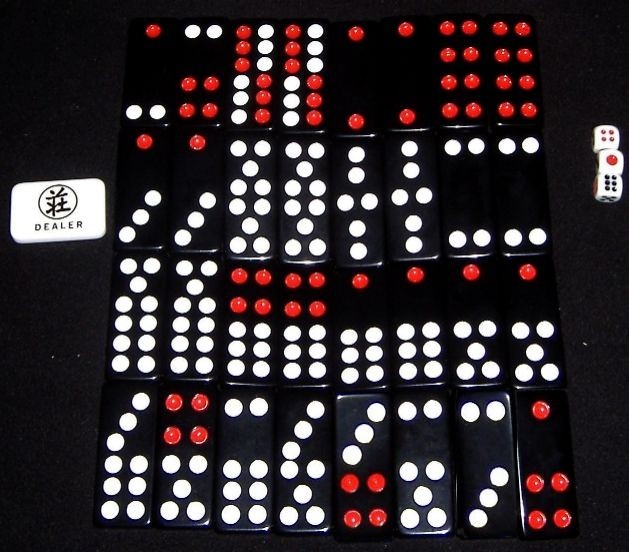
Materials (pictured above):
a set of Chinese dominoes (usually referred to as tiles)
a set of three Pai Gow dice
a banker button (the chung)
In
addition to the above, the casino game will be played on a felt table,
sort of like a blackjack table, with seven spots for players (six in
Atlantic City) and one for the dealer. Some tables skip the
number four as the Chinese consider four to be an unlucky number.
In a casino, the dice will be shaken in a dice shaker by the banker.
Description of materials:
The
dice are typical six-sided dice, but they have rounded edges to prevent
damage when shaken in a dice shaker at the casino. The spots on
the one and four sides are red, and all other spots are black.
There is no significance to the colors of the spots.
The
chung, even though it may say "Dealer", really identifies the banker.
Usually the dealer banks, but players may also bank in Pai Gow.
Players always know who is banking because the banker has the
chung.
There are thirty-two tiles in a set of Pai Gow tiles.
The tiles are made of hard plastic, approximately one inch wide
by two inches tall, and are black on the reverse side. The spots
are all white, with the exception of red spots that occur in groups of
one or four (just like the dice), and the Teen tile (the twelve-spotted
tile, in which half the spots are red). The color of the spots
has no significance, other than to make the tiles a bit easier to
identify.
Brief description of game play:
1) The Shuffle. The dealer shuffles the tiles face down and arranges them into eight stacks of four (the "woodpile").
2)
The Cut. The banker (usually the dealer, but could be a player)
"cuts" the woodpile. If the dealer is also the banker, he will "cut"
the woodpile according to the house way (which simply means he does
nothing more and will deal the tiles beginning with the stack the
farthest to his right). Players may choose from several different
methods of cutting the woodpile. In Las Vegas, the players (acting
as banker, of course) may actually cut the woodpile themselves, but I have
not seen this in Atlantic City.
3) The Deal. After the
cut, the banker shakes the dice shaker and the dealer reveals the dice.
Players must have their bets placed before the dice are revealed,
and they may not alter their bet afterwards. The dealer then
deals each position on the table a stack of four tiles,
counter-clockwise, starting with the position number as indicated by
the sum of the numbers on the dice. The tiles are always dealt
relative to the banker, with the banker taking position nine and one.
For example, if the sum of the dice were 12, the stacks would be
dealt starting with the position three spots to the right of the
banker. Other than determining which spot is dealt first, the
dice have no effect whatsoever on the game. There are always
eight positions on every table; so all eight stacks are dealt every
time. After the deal, the dealer will take the unplayed stacks
and put them off to the side. In Atlantic City, since tables only
have six spots for players and one for the dealer, one stack of tiles
is always burned.
4) The Setting of the Tiles. After the
tiles are dealt, players may examine their tiles and arrange them into
two hands of two tiles each (the high and low hands). When the
player is finished setting his hands, he places the two stacks back onto
his spot on the table. In Atlantic City, they require you to
place the stacks perpendicular to each other (like a T). In Las
Vegas, you simply stack them side-by-side.
5)
The Dealer Sets
His Hands. After all players have set their hands, the dealer
will
set his hands according to the House Way. The dealer has no
choice over how to set his hands. He must always play according
to the House Way.
6) The Comparison of
Hands. After the dealer has set his tiles, he will turn over each
player's tiles and arrange them so that the high hand is placed
horizontally and the low hand is placed vertically. Each player's
hands are then compared to the banker's hands (usually the dealer, but
again the banker could be a player). Players win if both their
high hand and low hand beat the banker's high hand and low hand,
respectively. The banker wins if his high hand and low hand beat
the player's high hand and low hand, respectively. If neither the
banker nor player with both hands, it is ruled a push and the player
does not lose his bet. Winning bets are paid even money, less a
5% commission to the house.
Detailed description of game play:
1) The tile rankings.
The
tiles in the photo above are arranged as pairs, with the
highest-ranking pair first (at the top-left corner) and the lowest
ranking pair last (at the bottom-right corner). Below are the
ranks of the tiles (1 being the HIGHEST rank, 15 the LOWEST), followed
by their Chinese and English names, as well as a brief description of
how each is used in play. Note that Gee Joon is ranked zero
because it is never used when comparing tile ranks against the banker.
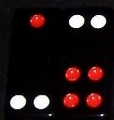
(Rank 0) Gee Joon - The
Supreme Pair. These are the tiles with three (arranged 1-2) or
six spots (arranged 2-4), respectively. When together, they form
the most powerful hand in the entire game. Gee Joon always wins
the high hand. When separate, the Gee Joon tiles are wilds.
They can be worth either three or six points, depending on which
is more advantageous to the player.

(Rank 1) Teen (Heaven) - Twelve
Spots. This is the second most powerful pair in the game, only
beaten by Gee Joon. When played separately, the Teen tile is
worth two points, unless paired with an eight or nine tile. When
paired with an eight tile, this forms a special hand called a Gong
("Treasure of Heaven", which can be said to be worth 10 points). When paired with a
nine tile, this forms a special hand called a Wong ("King of Heaven", which can be said
to be worth 11 points).

(Rank 2) Day (Earth) - Two Spots. This is
the third most powerful pair in the game. The Day tile is played
exactly like the Teen tile. It is worth two points, but when
paired with eights or nines it forms a Gong ("Treasure of Earth") or a Wong ("King of Earth").

(Rank 3) Yun (Man)
- Eight Spots, arranged 4-4. The fourth most valuable pair.
Worth eight points, but can form a Gong when paired with a Teen
or Day tile.
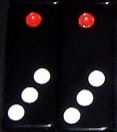
(Rank 4) Gor (Goose) - Four Spots, arranged 3-1. The fifth most valuable pair. Worth four points.
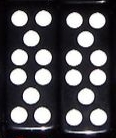
(Rank 5) Mooy (Plum Flower) - Ten Spots, arranged 5-5. The sixth most valuable pair, but worth zero points when separate.
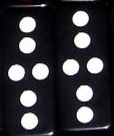
(Rank 6) Chong (Long Dress) - Six spots, arranged in a diamond shape. The seventh most valuable pair. Worth six points.
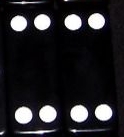
(Rank 7) Bon (Board) - Four Spots, arranged 2-2. The eighth most valuable pair. Worth four points.
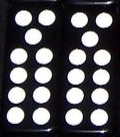
(Rank 8) Foo (Hatchet) - Eleven Spots. The ninth most valuable pair. Worth one point.

(Rank 9) Ping (Partition) - Ten Spots, arranged 6-4. The tenth most valuable pair. Worth zero points when separate.

(Rank 10) Tit (Long Leg) - Seven Spots, arranged 6-1. The eleventh most valuable pair. Worth seven points.

(Rank 11) Look (Big Head) - Six Spots, arranged 5-1. The twelfth most valuable pair. Worth six points.
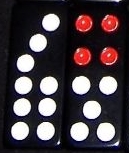
(Rank 12) Chop
Gow (Mixed Nine) - Nine Spots, arranged 5-4 or 6-3. The
thirteenth most valuable pair. Worth nine points. Can form
a Wong when paired with a Teen or Day.
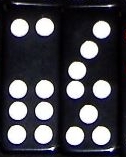
(Rank 13) Chop Bot (Mixed Eight) -
Eight Spots, arranged 6-2 or 5-3. The fourteenth most valuable
pair. Worth eight points. Can form a Gong when paired with
a Teen or Day.
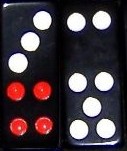
(Rank 14) Chop Chit (Mixed Seven) - Seven Spots, arranged 5-2 or 4-3. The fifteenth most valuable pair. Worth seven points.
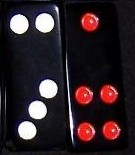
(Rank 15) Chop Ng (Mixed Five) - Five Spots, arranged 3-2 or 4-1. The sixteenth and least valuable pair. Worth five points.
The
individual tile rankings are the same as the pairs I described above,
except that the Gee Joon tiles are not used for the purposes of
comparison (this will be explained later). This means that even
though Gee Joon forms the most powerful pair in the game, when they are
used as individual tiles they are worthless for comparison purposes.
The
tiles are essentially randomly ranked and simply must be memorized.
To the Chinese, the rankings may make more sense. For
example, the Teen is ranked above the Day because Heaven is above
Earth. Also, I have read that the patterns on the tiles resemble
Chinese characters, but I have not confirmed this.
2) The Object of the Game.
The
object of the game is simple - to beat the banker. The banker is
usually the dealer, but players may also bank. However when a
player is banking, other players usually do not bet as a courtesy to
the player who is banking. The Chinese are also superstitious in
that they usually only bank after they lose a hand (even though the
casino allows you to bank a max of every other hand), the rationale
being that if you're winning why change a good thing. This is a
silly superstition because the banker has the advantage of winning copy
hands, and the tiles are shuffled after every round so each round is
random anyway. If a player is banking, the dealer will wager
against that player an amount equal to the player's last wager against
the dealer.
3) How to Beat the Banker.
In order to
beat the banker, you arrange your four tiles into two hands of two
tiles each. The better (higher-scoring) hand is called the high hand. The lower-scoring hand is the low hand. You win when your high hand is better
than the banker's high hand, and your low hand is also better than the
banker's low hand. Note that you need to maximize the value of
BOTH hands in order to win, so your low hand must also have as high a
value as possible. In fact, you usually want to arrange your
hands with the goal of maximizing the LOW hand.
4) Scoring the hands.
The
most powerful hands in the game are pairs (in Chinese, "Bo"). When you examine your
tiles, you want to look for pairs first. The power of each pair
is listed above. For example, based on the rankings, a Yun pair
would beat a Chop Bot pair (although both pairs' tiles have eight
spots, Yun is ranked higher than Chop Bot), but a Gee Joon pair would
beat a Yun pair.
The
second most powerful hands are Wongs (11 points) and Gongs (10 points).
A Wong is a Teen or Day (12 or 2) paired with a Chop Gow (a
tile with 9 spots). A Gong is a Teen or Day paired with a tile
with 8 spots (Yun or Chop Bot). Note that a Wong beats a Gong.
If
you do not have a pair, Wong, or Gong, you must maximize the value of
your hand by coming as close to nine points as possible. Since
pairs, Wongs, and Gongs are relatively rare, most of the time you will
be trying to make nine. Pai Gow means "make nine" in Chinese.
To determine the value of your hand, you simply add up the spots
on each tile and drop the tens digit. But remember that the Gee
Joon tiles are wild and can be worth three or six points. For
example if you have a Foo (11) and a Look (6), your hand is worth 7.
Similarly, say you have the Foo and the Gee Joon tile with three
spots. This hand is also worth 7. Hands with a Teen or Day
and a seven tile are worth 9 and are called High Nine because they are
the most powerful 9 in the game.
In the event that one (or both)
of the player and banker's hands tie, the highest ranking tile of the
player's hand is compared to the highest ranking tile of the banker's
hand. The hand with the higher-ranking tile wins. In the
event that the high tile is the same rank, the banker wins.
In
the event that the player's low hand is a zero, the player's low hand
always loses (even if the banker also has a low hand of zero).
In summary:
Pairs > Wongs (11) > Gongs (10) > 9 or less.
In
the event of a tie, the high tile of the player's hand is compared
against the high tile of the banker's and the hand with the
higher-ranking tile wins.
But,
the banker always wins against low hands of zero and copy hands (hands
where the point value is the same and the high tiles are the same rank).
Strategy:
Since
it would take many, many pages to discuss am optimal Pai Gow strategy,
I will keep this section very simple. Most of the time it will be
very obvious how you should arrange your hands. Since you have
four tiles, there are only three different ways to play them.
About a third of the time, one of your three options will
dominate the other two (meaning that the high and low hands are both
the best possible). When you are dealt a hand like this, you of
course will play the option that dominates. This is called the
Only Way.
If no option dominates, the traditional strategy is to
maximize the low hand. This usually involves pairing the tile
with the most spots with the tile with the least spots. Sometimes
by maximizing the low hand, you may end up with both a poor high and
low hand, such as 2-3 or something. But if you can vastly
increase the value of your high hand by sacrificing a point or two from
your low hand (to say, 0-9 or 1-8), it may be worth it to maximize your
high hand instead.
If you have an option to play two of either a
high nine, Wong, or Gong, you would usually play the lower of the two
options (ie, the Gong over the Wong, or the high nine over the Wong).
The idea is that you will still have a valuable high hand, but
you will add a point or two to your low hand.
Sometimes it is
advantageous to split pairs. For example, if by splitting a pair
you could vastly increase your low hand (say from 1 to 7), it may be
worth it to split the pair. However, there are some pairs you
would never split. Never split pairs of tiles with 4, 5, 6, 10,
or 11 spots.
A final point: If you are unsure how to set your tiles, you can always ask the dealer to tell you the House Way.
Different Styles of Cutting the Tiles (Followed by their English names):
I
found this list of eighteen different ways of cutting the tiles (not
including the House Way) on an Australian casino website. The
name is followed by the options the player may choose for the dealer to
deal the stacks.
Yat Dong Dong (One Stack) - From right or left.
Cup Say (Tiger) - From right or left, top or bottom.
Chee Yee (Chop the Ears) - From top or bottom.
Dai Pin (Big Slice)
Jung Quat (From the Heart) - From top or bottom.
Long Tau/Fong May (Dragon Head/Phoenix Tail) - From right or left.
Wui Fung Bank (Hong Kong Bank)
Foot Say (Four Across)
Ghan Dong Ping Say (Kangaroo Jump) - From right or left.
Pong Yun (Buddha's Signal) - From right or left.
Bo Bo Go Sing (Boy Walks Up Stairs) - From right or left.
Ghan Dong Cup Say (Striped Tiger) - From right or left.
Yat Kai Sum May (Chicken Three Ways)
Arn Lok Peng Sar (Flying Dragon) - From right or left.
China Bank (China Bank)
Chong Wan Sup Lok (Sixteen Across)
Seung Gwai Pak Moon (Ghost Closing the Door)
Gum Un Que (Double Bridge) - From right or left, front to back.
Pai Gow Superstitions:
This
section will list superstitions I have come across in my experience
playing Pai Gow. I will keep adding as I hear about new ones.
I have no reason to believe that any of these are grounded in
reality:
Superstition: Don't play number/position four. It is unlucky.
Reality:
The tiles are randomized after every hand, and the dice roll
further randomizes the order in which the tiles are dealt. The
position you play makes no difference.
Superstition: You shouldn't bank unless you have lost the last hand. Why break up a winning streak?
Reality:
You want to bank as often as possible, whether you are winning or
losing. The banker has the advantage of winning zeroes and copy
hands, and only pays commission on net winnings.
Supertition: Betting two/three/seven hands is better than betting one.
Reality:
It is actually to your disadvantage to play more than one hand,
especially if you are playing by yourself and banking every other
round. If you play two hands against the dealer, you can only
play one hand the next time you bank. This is the equivalent of
banking every third hand instead of every other hand.
Summary:
Pai
Gow is an extremely fun game, and it is worth the time it takes to
learn it. It is probably the most complicated casino game, but
since about 40% of hands result in pushes, it is very difficult (though
not impossible) to lose your money as fast as in other games (say,
blackjack). It is therefore a much more fair game, the house
edge entirely coming from the commission on winnings, and much less
volatile than other games at the casino.
Back Bio Bloodninja Calculus C++ Food Liquid Courage
Metal Pai Gow Photography Power Travel Writings
disgorge@undertheblade.com
















